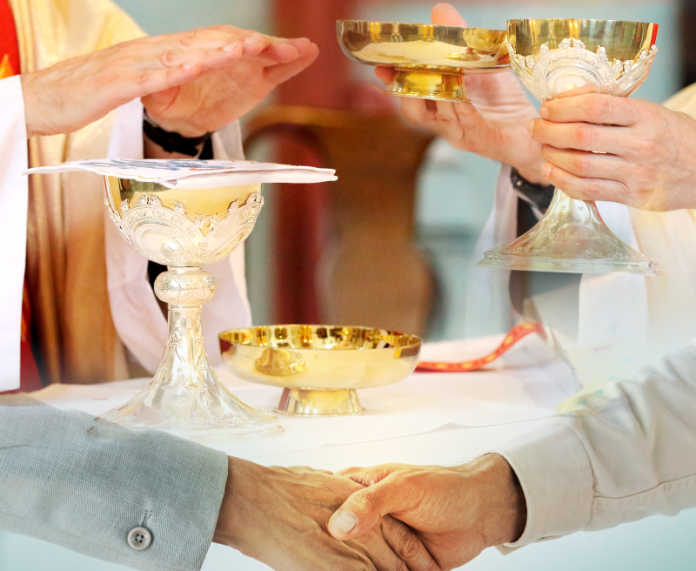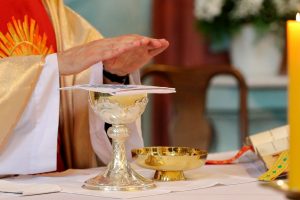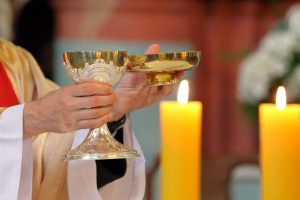
The Eucharist as a sign of unity and a bond of charity
SR. MARY MICHAEL FOX, OP
On the night before he died, our Savior instituted the sacrament of the Eucharist and prayed for unity among his apostles and all those who would come to know him through their preaching (see John 17:21). This was no coincidence. The Eucharist is “a sign of unity and a bond of charity” because it effects in the faithful participant a real unity with God and unity with fellow members of the Church (see Catechism of the Catholic Church, 1323). In this article, I will explore this vertical and horizontal unity that the Eucharist effects by examining three gestures at Mass: the Epiclesis, the Offering, and the Sign of Peace.
The Epiclesis
 The first gesture is the Epiclesis, which is Greek for “invocation.” At the beginning of the Eucharistic Prayer, the priest extends his hands over the chalice and patent and asks the Father to send down the Holy Spirit upon the gifts of bread and wine so “they may become for us the Body and Blood of our Lord Jesus Christ” (see Eucharistic Prayer II).
The first gesture is the Epiclesis, which is Greek for “invocation.” At the beginning of the Eucharistic Prayer, the priest extends his hands over the chalice and patent and asks the Father to send down the Holy Spirit upon the gifts of bread and wine so “they may become for us the Body and Blood of our Lord Jesus Christ” (see Eucharistic Prayer II).
The Holy Spirit is the bond of love and unity between the Father and the Son, and it is this same Holy Spirit that makes Jesus truly present in the Eucharist. That is, the power of the Holy Spirit works through and with “the power of the words and the action of Christ” to make sacramentally present the Body and Blood of Jesus Christ (see CCC, 1353). Hence, to receive Jesus in the Eucharist is to receive this Holy Spirit — this bond of love. Just as the Holy Spirit is the source of unity in the Trinity, the Spirit is the source of unity in the Church. We hear this described when the priest prays Eucharistic Prayer III: “Grant that we, who are nourished by his Body and Blood, may be filled with his Holy Spirit, and become one body, one Spirit in Christ.”
Entering into this sublime gesture of the Epiclesis, we beseech the Holy Spirit to transform not only the bread and wine on the altar but to transform all of us gathered in worship so that we become more united as the Mystical Body of Christ. Again, in Eucharistic Prayer II, the priest prays: “Humbly we pray that, partaking of the Body and Blood of Christ, we may be gathered into one by the Holy Spirit.”
The Epiclesis is one of those moments in the Mass that point to the reality of how, through the power of the Holy Spirit, the Eucharist brings about our unity with God and with each other. The more conscious we are of the Holy Spirit’s action in the liturgy, the more intentional will be our prayer that he unite us with God and with one another.
The Offering and Final Doxology
 At the conclusion of the Eucharistic Prayer, we see another gesture of the priest called the Offering. The priest lifts the paten and chalice that now contain the precious Body and Blood of Jesus Christ and proclaims: “Through him, with him, in him, in the unity of the Holy Spirit, all glory and honor is yours, almighty Father, for ever and ever.” We respond: “Amen.”
At the conclusion of the Eucharistic Prayer, we see another gesture of the priest called the Offering. The priest lifts the paten and chalice that now contain the precious Body and Blood of Jesus Christ and proclaims: “Through him, with him, in him, in the unity of the Holy Spirit, all glory and honor is yours, almighty Father, for ever and ever.” We respond: “Amen.”
What’s happening here?
Jesus promised his apostles: “And when I am lifted up from the earth, I will draw everyone to myself” (John 12:32). Though there are still many people who have not yet experienced the fullness of Our Lord’s redemptive sacrifice in their lives, nevertheless his promise stands. Jesus is drawing all people to himself, fulfilling the desire of God the Father that we would be one with him and with each other (see Ephesians 1:3-13).
At every Mass, the actions of Jesus that took place in Jerusalem at a particular place and at a particular time “become in a certain way present and real” (CCC, 1363). We are there. This is the mystery of time and timelessness that we experience in the Divine Liturgy. In the gesture of the Offering, the priest lifts up the chalice and patent that now hold the Precious Body and Blood of Jesus.
Here is Jesus who “offered himself once in a bloody manner on the altar of the cross … contained and offered in an un-bloody manner” (CCC, 1367).
Here is Jesus, whose Precious Blood is poured out for the salvation of the world.
Here is Jesus, through whom we are reconciled and united to God the Father. “Through him, with him, and in him, in the unity of the Holy Spirit all praise and glory be yours, Almighty Father” (see CCC, 1361).
Here we have an affirmation of the reality that Jesus is being lifted up to reconcile us to the Father. Yet here, too, is an invitation to us to enter into the mystery that is before us on the altar — the mystery of the sacrifice of Jesus that brings us into the inner life of the Trinity.
The reality is before us to be recognized and affirmed. Do we want this union? Do we want to be drawn up into the heavenly realities — the mystery of being saved by Jesus who is being lifted up on the altar? Let us with full heart, mind, soul, and strength say “Amen!”
The Our Father and the Sign of Peace
 Following the two gestures of the Epiclesis and the Offering that signify the vertical unity between God and his Church, the liturgical prayers and gestures begin to introduce the horizontal unity that the Eucharist effects among the members of the Church.
Following the two gestures of the Epiclesis and the Offering that signify the vertical unity between God and his Church, the liturgical prayers and gestures begin to introduce the horizontal unity that the Eucharist effects among the members of the Church.
After the great “Amen,” the congregation stands and prays, with one heart and one voice, the Our Father. It is a prayer of unity and a prayer for unity. We address God with the pronoun “our,” recognizing that through the sacrament of Baptism, we have become children of the same heavenly Father. At Mass, we pray the Our Father because we are not isolated persons saved by Jesus. No, we are his Mystical Body — his holy people. The union among us is real: We are the Church. We affirm this with our prayers and our actions at Mass.
Immediately following the Our Father is the simple yet deeply significant gesture of unity called the Sign of Peace. We turn to those near us and offer our hand in fellowship, an embrace of love, or a nod of recognition that says “Thank you for being here. I need you to be here as a fellow member of Christ’s body. Without your prayers, your sacrifice, and your witness, I wouldn’t be able to persevere on this journey of faith. For this reason, I may not hold any grievance against you, and so I extend to you Christ’s peace.” Imagine how dynamic this sacred gesture would be if everyone had a similar understanding of how much we need each other as members of Christ’s Body (see 1 Corinthians 12:15-26).
Again, the gesture signifies the reality. United in Christ’s peace, we are called in one body (see Colossians 3:15; Hebrews 12:14).
May they be one…
Jesus gave his whole life that we might be one with him and with each other. In these three gestures of the Mass — the Epiclesis, the Offering, and the Sign of Peace — we see the cross that brought about the reconciliation between God and us and among God and one another. Our Church is not immune to the divisive ideologies that plague our culture, but we must resist the temptation to allow differences to separate us from Christ or from one another. Our only hope to preserve the unity that Christ established is to enter deeply into the Eucharist, our source of unity and charity.
We know that the more intentional one’s participation is in the Mass, the more disposed he or she is to receive the graces contained therein. How important it is, therefore, that catechists draw attention to the gestures of unity found in the Mass so as to help those they catechize enter more fully into that vertical unity with God and that horizontal unity with fellow members of the Church.
Sr. Mary Michael Fox, OP, PhD, is a member of the Dominican Sisters of St. Cecilia (Nashville). She has taught “all ages from 3 to 93.” Sr. Mary Michael conducts formation events for school and parish catechists throughout the United States. Her forthcoming book will examine the pedagogy of The Catechesis of the Good Shepherd.
This article was originally published in Catechist magazine, November/December 2019
IMAGES: WIDEONET/ISTOCK, (HANDSHAKE) LIGHTFIELD STUDIOS/SHUTTERSTOCK




